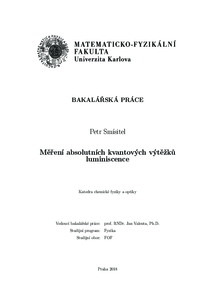Měření absolutních kvantových výtěžků luminiscence
Determination of absolute quantum yield of luminescence
bachelor thesis (DEFENDED)

View/
Permanent link
http://hdl.handle.net/20.500.11956/99978Identifiers
Study Information System: 197617
CU Caralogue: 990021932590106986
Collections
- Kvalifikační práce [11964]
Author
Advisor
Consultant
Fučíková, Anna
Referee
Herynková, Kateřina
Faculty / Institute
Faculty of Mathematics and Physics
Discipline
General Physics
Department
Department of Chemical Physics and Optics
Date of defense
26. 6. 2018
Publisher
Univerzita Karlova, Matematicko-fyzikální fakultaLanguage
Czech
Grade
Very good
Keywords (Czech)
luminiscence, kvantový výtěžek, nanostrukturyKeywords (English)
luminescence, quantum yield, nanostructuresV této bakalářské práci se budeme zabývat určováním absolutního kvantového výtěžku (účinnosti) fotoluminiscence, která je rovna podílu počtu vyzářených fotonů a počtu absorbovaných fotonů. Velmi častým postupem měření je porovnání absorpčního a luminiscenčního spektra. Hlavními problémy ex- perimentu bývá odstranit vliv úhlové závislosti reflexe, emise a rozptylu. Proto je vhodné použít v experimentu integrační kouli, která eliminuje většinu problémů relativního měření výtěžku. Podrobně si popíšeme metodu měření výtěžků luminiscence s pomocí integrační koule včetně použité aparatury, procesu zpracování naměřených dat a odhadu nejistoty měření. Následně uvedený postup aplikujeme na kapalné i pevné vzorky obsahující křemíkové nanokrystaly. Změříme závislost kvantových výtěžků luminiscence na vlnové délce excitačního záření. 1
In this bachelor thesis we will study the determination of absolute quantum yields (efficiency) of photoluminiscence, which is equal to the ratio of number of emitted photons and number of absorbed photons. The common approach is to compare the absorption and luminescence spectrum. The main experimental problem is to eliminate the influence of angular dependence of reflection, emission and scattering. Therefore it is convenient to use the integrating sphere which eliminate most of the problems of relative measurements of quantum yield. In detail we will describe the method to determine the quantum yields of luminescence using the integrating sphere including the description of the experimental equipment and the procedure of processing data and estimation of uncertainty. Finally, we apply the procedure to solid and liquid samples containing silicon nanocrystals. We will measure the dependence of quantum yields on the applied excitation wavelength. 1
